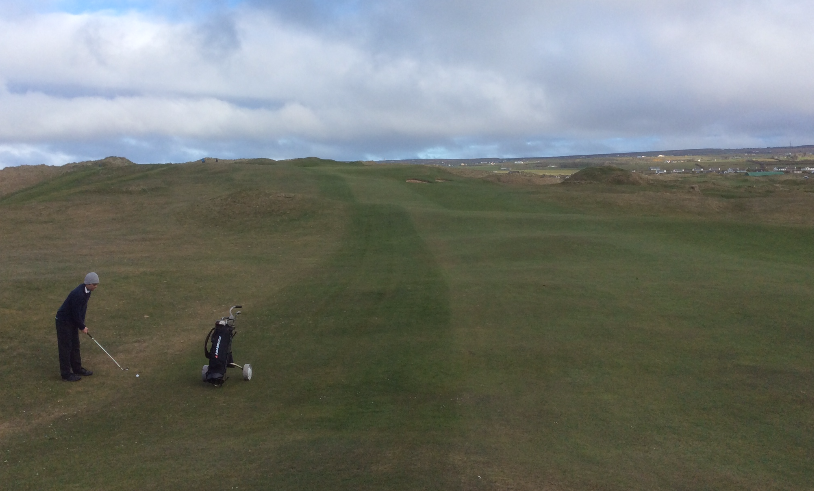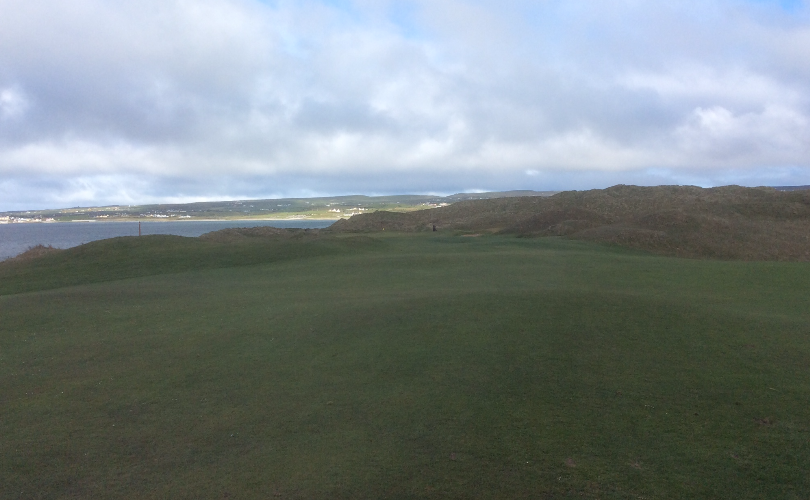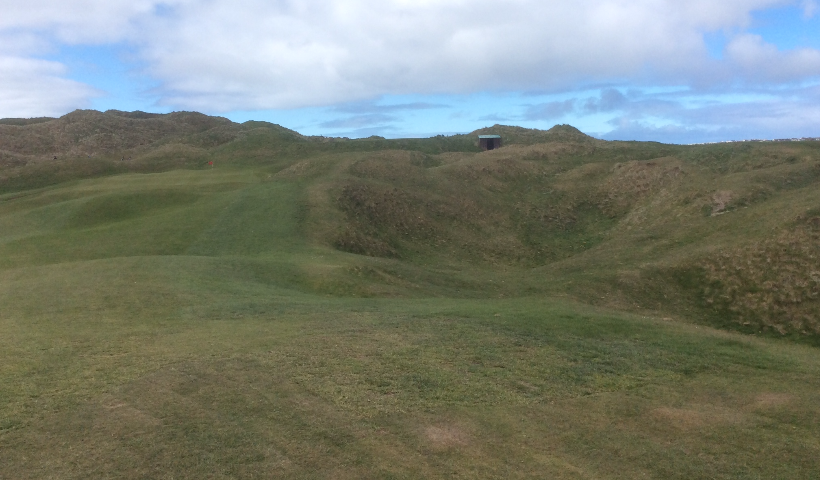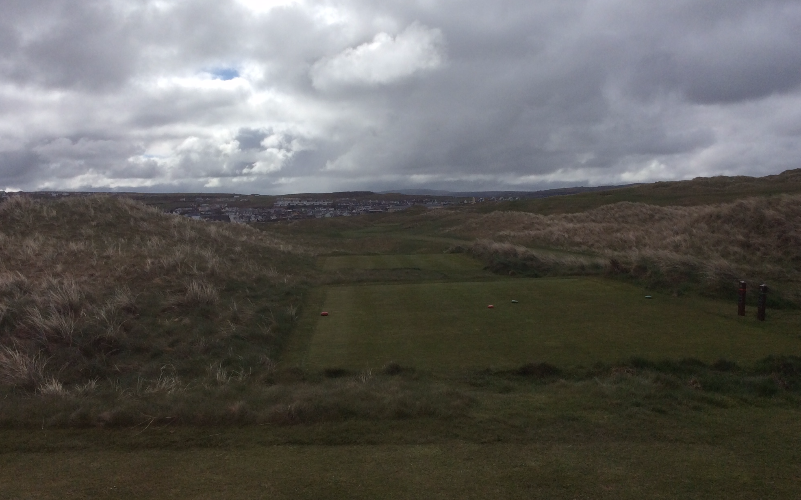The Old Course at Lahinch, located about an hour north west of Shannon, was founded in 1892 and initially designed by Old Tom Morris. It was then redesigned by Alister MacKenzie in 1927 (the designer whose portfolio also includes Augusta and Cypress Point). Its atmosphere and location are everything I imagine when thinking about a European golf course. Like St. Andrews, it is in the middle of the town--we walked there from our hotel on Main Street. And it was filled with locals, as opposed to some of the other courses we played that felt like golf vacation destinations. The local feel of the place is augmented by the fact that there is a second course on the property--the Castle Course--that is more like a municipal course where people seemingly meet up for their weekly round or to practice after school.
My takeaway impression was that Lahinch is links golf at its finest. The course is on the ocean, but sufficiently sheltered that we were able to have a clear day with manageable winds. Further, the course is beautiful, but not only because of the stunning ocean views (on many holes you would not even know the ocean is there). Instead, the fescue grass and natural terrain of the land are the stars of the show. It is said that when constructing Bandon Dunes, a lot of land was moved to make it seem like no land was moved at all. I have played the courses at Bandon and know exactly what this means. As you walk Bandon Dunes and Pacific Dunes, you feel like the towering dunes and fescue around you are natural and have been there forever. Bandon did an amazing job of making its redesign of the land seamless (unlike other courses, which, though cool, it is clear that their features are artificial). Lahinch is the real deal. Walking the course gives you the impression that the designers took a piece of land and cut a golf course through it, rather than having a golf course in mind and changing the land accordingly. Also adding to its true links nature, the green complexes allow for a lot of creativity (e.g. bump and run approaches are often possibile), but are also severely sloped such that a chip that misses its landing spot can roll directly back to your feet (this is, after all, the same guy who designed the ninth at Augusta where Greg Norman's unraveling began when his approach landed ten feet from the hole, but rolled off the green and 20 yards down the fairway). Lastly, there are bunkers....everywhere (one of which the scorecard refers to as "the bunker from hell"...more on that later).
I left Ireland thinking Lahinch was the third best course I played. Upon reflection, I am confused. Ballybunion was a great golf course with jaw dropping scenery. But Lahinch may be a better designed golf course. Then there is Portmarnock, which is the best design of all three, but least scenic (but, by no means is it completely lacking in scenery, we are talking in relative terms here). In any event, if you are going to the west coast of Ireland, it would be unconscionable to not play both Ballybunion and Lahinch. Ultimately, I think Ballybunion is better. Though its opening few holes are weak, the rest are extraordinary, equal to those of Lahinch, and much more scenic. So, I think Ballybunion bests Lahinch. Then, the scenery at Lahinch is comparable to Portmarnock, but Portmarnock is a more interesting golf course, so Portmarnock bests Lahinch. Looks like my first instinct was right.
Now, onto some individual holes.
I am always a sucker when golf courses have flags flying. Part of it is that I really enjoy playing golf, especially when traveling, because you get to meet new people that you may never otherwise meet. In Ireland, we played Ballybunion with "Jimmy" from Queens and Old Head with the founder of a tech company. When I was traveling alone at Bandon Dunes, I played with a couple from Nashville who were there celebrating the wife's retirement. The characters you meet are countless and, no matter where you are from, the game of golf provides a common frustration that makes striking up conversations easy.
***On all of my reviews, you can now click on the first image to see a slideshow of all images on the page.
This picture, from the first tee, shows just how close you are to the town of Lahinch.
The first is a 373 yard uphill par four. The tee shot is not intimidating except for the fact that you are hitting directly in front of the starter and the caddyshack. You do not want to be the dumb Americans that just got off the plane and top your first tee shot. My brother made the situation even worse by asking the starter what the course record was (simply out of curiosity), but the starter seemingly thought he was trying to break it. At least he hit his first shot sufficiently well that it was at least plausible he was a very good golfer. After the easy tee shot, your approach is to a green perched atop a hill with a false front such that any shots short or right will roll back down (and, if right, into a bunker). It is a good opening hole-not very easy, but not too hard (ranked as the eighth hardest on the course). Knock the rust off, take a bogey or get lucky with a par, and move on to the second.

Approach to first green where you can see the false front that will feed balls back towards the fairway or into the bunkers on the right.
The second is a 523 yard par five with bunkers to avoid the whole way (off the tee, on your second, and into the green). Though, as we would learn, hitting a fairway bunker is not the end of the world. Chip out and move on. Probably lose a stroke, but it will only be disastrous if you try to be heroic.

View from second fairway.
The third is one of my favorite holes- a 418 yard par four with a blind uphill tee shot where the guidebook's advice is to aim just right of the 50 foot dune guarding the entrance of the fairway. Then, you are still left with a long second shot to a green that is backdropped by the ocean.

Third tee shot (with the ocean just out of view on the left).

View from third fairway.

Third green. Again, you can see the false front protecting the front and right of the green.
The fourth is another one of my favorites- a 472 yard par five with an enormous dune in the middle of the fairway. According to the guidebook, "try to use the natural run of the links to play your second shot onto the green by taking a club less and hitting the shot as low as possible over the 'V' in the Klondyke Hill." How can that not be an awesome hole?

Fourth tee.
The fifth is supposed to be a highlight of the golf course. Known as the Dell Hole, it is a 148 yard par three to a narrow green hidden by a gigantic dune. The green is only 12 yards deep with another dune behind it. Basically, it requires the perfect distance to land over the first dune, but short of the second. Unfortunately, this hole is not in play during the "winter" months, and, as we were there a few days prior to May 1, the winter green was in play. The winter hole is not noteworthy, and I look forward to returning to Lahinch to play this hole properly. As a general comment for our trip, we were able to take advantage of reduced green fees by playing early in the season (most courses have reduced rates prior to May and some even have reduced rates into the first week of May). The only place where I felt we were shortchanged by playing in the winter was this one hole at Lahinch. Not bad given we saved a few hundred bucks by coming when we did.
The sixth is another great golf hole (the second hardest on the course). A par four measuring 412 yards with a colossal pit in the middle of the fairway similar to the one in Star Wars where Jabba the Hutt tries to throw Luke (not really, it just has a bunker and real tall grass). We thought the pit would be too long to reach off the tee as it is 270 yards away. But, this was the first course we played in Ireland, so we did not yet have a sense of how much the fairways ran. My brother wound up in some thick grass in the pit. With the helpful Irish fairways my brother and I would often find ourselves hitting drives in excess of 270 yards (with the longest my brother hit being 290). By comparison, at home, we are happy when we fly the ball 230-240 and get 10 yards or so of run out.

View from sixth fairway with the pit starting to come into view.

This photo does not do the pit justice. It is about 20 feet deep with a pot bunker directly in the middle.
The seventh is yet another strong hole. A 366 yard par four with a blind uphill tee shot. I know some people have a problem with blind shots and think they are design flaws. To me, it depends. If a course has artificially created lots of blind shots, then the feature can get tiresome. But, if you feel like the terrain simply requires a blind shot, then I am happy to roll with it.

Seven tee.

Just how close you are to the ocean on seven tee.

View of seventh green, where you can again see how central the false fronts are at Lahinch.

Seventh green right on the ocean.
Eight was the first of many memorable par threes we would play on the trip. 156 yards uphill to a green surrounded by bunkers and dunes. There is no reason you should be spraying your 150 yard club 20 yards left or right, so the tall fescue in the dunes should not be intimidating, but it most certainly is from the tee. The only safe place to hit it is the green. Immediately beside the green are deep bunkers and, if you hit a desperately poor shot, then you will have to hit from the fescue, which may cause the bunkers to yet again come into play.

View from eighth tee.
The ninth is a nice way to close the nine- a 391 yard par four with no trouble off the tee, but a treacherously sloped green. The green is guarded by a huge bunker, is 56 yards deep (thus making three putts especially likely), and has the steepest false front on the course. For first timers playing the course, it is unlikely you will escape nine with a par. You may very well get on in two, but a three-putt is more likely than not.

The ninth green with its false front and deep bunker. Luckily none of us were in that bunker, as I highly doubt we would have been able to get out of it, let alone get out of it and hold the green.
The back nine, for the most part, turns away from the water, but that is the great thing about Lahinch. It is simply a masterfully designed golf course, so it does not need the ocean to make it special.
The tenth, a 424 yard par four, is among the most difficult on the course. Not only is it long, but there are three large bunkers short of the green, so if you are not super long, there is a good chance that even two solid shots will not get to the green, which will lead to trouble.

View from the tenth fairway with the bunkers short of the green starting to come into view.
The eleventh is another fun par three measuring 156 yards downhill. It is tricky because it is difficult to gauge how much to adjust your distance for both the wind and the elevation change. Don't come up short though, as the green is protected by three bunkers, including the "bunker from hell." I hit a terrible shot from the tee, ended up in the bunker from hell, but got out and made a four on the hole. I intend to do a post on the course I grew up playing as a kid in New York's Hudson Valley. It is nothing terribly special, but certainly a solid course. Just how good of a course it is (and how challenging) only became apparent to me recently as I started playing more courses. One of its central features is exceptionally deep bunkers, which prepared me well for the pot bunkers of Ireland. As long as I had a decent lie and was not too close to the face, I was usually able to get out of Ireland's bunkers in one shot. I used to be an insanely good bunker player when I was younger. Now, I can manage to get out of the trap and leave it twenty feet from the hole, but I do not get up and down like I used to. Lose some of the feel when you don't play every day I suppose.

View from eleventh tee.

The "bunker from hell."
The twelfth is a 514 yard par five with a memorable view from the tee- an ocean inlet running up the left and the ruins of a castle (the namesake of the other course on the property- the Castle Course) in the distance that serves as your aim. The green is again well protected by bunkers.

Twelfth tee.

Good luck hoping that your second shot scampers up to the twelfth green.
The thirteenth might be the funnest hole on the course- a 267 yard par four. And, with no bunkers guarding the front of the green, you may be able to bounce it up there. However, there is a large swale on the right with tall grass that will catch an inaccurate drive.

You can see how close the swale is to the green.
The fourteenth is another long par four measuring 450 yards, though it is downhill. Furthermore, the green is guarded by two enormous mounds with a small chute between them, thus preventing your ball from running up to the green unless you get very lucky by landing your ball directly in between the mounds and having it kick straight instead of sideways.

Fourteenth tee.

Quite the narrow landing strip leading up to the fourteenth green.
The fifteenth is the hardest hole on the course. Not too much to it, just a long par four at 439 yards. Though shorter than fourteen, it is not downhill. Just have to hit a long straight shot, twice.

Fifteen tee. The fairway is there somewhere. As a general rule, assume the fairway is somewhere near the end of the walkway leading from the tee box.
In my opinion, two of the last three holes (16 and 17) are weak (perhaps the only weak holes on the course). In fact, it appears as though we failed to take pictures on the last three holes. The sixteenth is a 192 yard par three. There is nothing particularly bad about it, just nothing special. The green is quite generous and, though surrounded by bunkers, the green is so large, even a shot a bit off should be safe. The seventeenth is a 408 yard par four with little trouble off the tee. The hole's difficulty comes from the bunkers protecting the front of the green for what is likely a lengthy approach shot. I do like the eighteenth hole- a 503 yard par five. The landing area for your tee shot is littered with bunkers. Hit it too far- bunker. Too far left- bunker. Too far right- bunker. There is also a bunker that would catch a ball topped off the tee (as if topping your tee shot on a par five is not enough to put you behind the eight ball). If you can navigate the tee shot, then it is a green light for your approach to the green. You will likely have about 240 left to the green and there is no trouble in front of the green, so a well hit fairway wood can indeed bounce onto the green. That is exactly what my brother did and we videoed his eagle putt.
Pretty cool to make an eagle on your first round in Ireland. After we left the eighteenth green we said thank you to the starter, and he commented on how excited my brother appeared on his putt on 18. My brother told him it was for eagle, so between that and his solid first tee shot, it was not a total embarrassment that he asked what the course record was. A good start to the vacation- my brother shot 84 and I shot a 91. His 84 was an impressive score for our first round in these conditions. I felt my 91 was also strong when you take into account the wind, often not knowing where the heck to hit the ball, and the general adjustment to links golf.
Lahinch is a world class course that deserves its ranking at 65 in the world. It has very few weak holes, many strong holes, and some great views. Assuming you get to play the actual fifth hole, it has three memorable par threes (for whatever reason par threes are often the holes I most remember).
Also, Lahinch is a fun city. We landed on a Saturday morning at Shannon and went directly to Lahinch. Our round was not until Monday, so we spent two days in the area not golfing. On Saturday, we went to the Cliffs of Moher (20 minutes from Lahinch)--Ireland's most visited natural tourist attraction. On Sunday, we boarded a ferry to the small island of Inis Mor. Most tourists (and the island is really designed around tourism) rent bikes and travel the island seeing the various sites (an old shipwreck, a lighthouse, castle ruins, and the the many farm animals along the way). If you go in the summer, Lahinch also seems to be a surfing mecca in Ireland. I actually went in the ocean while in Ireland (more on that in the Ballybunion review). I only stayed in for thirty seconds, and I can't imagine spending an extended period of time in the water surfing (unless you get yourself a real thick wet suit). If you go, I would recommend staying at the Atlantic Hotel on Main Street. It was nothing super special, but the rooms were charming, it was in the middle of town, and it offered a reasonable rate. It was what I expected in an Ireland hotel- a small room directly above a pub. I would, though, recommend asking for a room with a window that does not face the street, as it was apparent on Saturday night that you were above a pub.
All in all a great start to our trip. We finished playing Lahinch at noon and had a tee time at Doonbeg that same day at 3:00. So, into the car we went to move on down the coast.
















































Comments